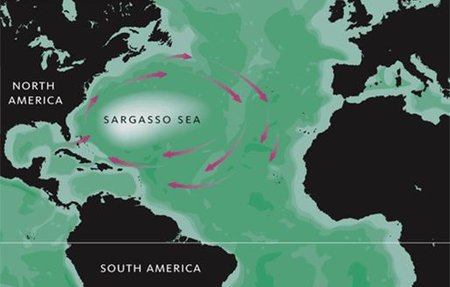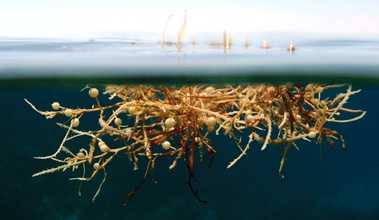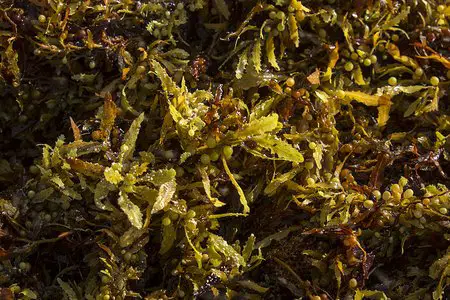Sargasso Sea
The Sargasso Sea is a strange and a unique creation of the nature. The vast sea area which is about 700 miles wide, 2000 miles long and located within the North Atlantic, has no shores. The sea area extends from 30° to 70° west and from 20° to 35° north. It is bounded by ocean currents on all sides. To its west is the Gulf Stream Current, on its east is the Canary Current, northern side is bounded by North Atlantic Current, and the south by North Atlantic Equatorial Current. The island of Bermuda is located on its western fringes and it's the only landmass within Sargasso Sea.
Sargasso Sea
With such ocean currents on all sides, this sea area unlike the harsh cold North Atlantic, is strangely warm with stable weather conditions and has calm and weak winds. Another strange phenomenon which is nowhere seen in the world is, this vast water area is covered with some dense seaweed which forms a thick mat on its surface. This free floating golden-brown seaweed is knows as Sargassum and therefore such name of the sea.
Although the Sargasso Sea remains calm with its surrounding currents, a subtropical gyre is formed here. As a result the entire sea area with its mat like weeds slowly rotates clockwise. However, the rotation and its speed also depends on the surrounding weather conditions.
Sargassum Seaweed found in Sargasso Sea
Some Portuguese sailors first discovered Sargasso Sea with its mat of seaweed in the early 15th century. Even Christopher Columbus who sailed through it in 1492 with his fleet of three ships and 90 men, thought that he must had reached the land as he looked at the vast stretch of dense brown surface. They initially feared that their ships might run aground on hitting the landmass as they did not anticipate that it could be weeds, because weeds are usually seen in shallow waters near the shores. But in reality, the sea here is several miles deep.
It is known today that these seaweeds are not blown into this area from the shores by the water currents. They are actually native to this area and grow here vigorously hundreds of miles away from the shores. Although there are similar such currents in other oceans like in the South Pacific and North Pacific that too rotate, but there is no record of such thick formation of seaweed in any such areas.
It is also known that due to the ocean currents, vast amount of marine plants and even trash get drifted into Sargasso Sea from the nearby ocean areas and get embedded into these weeds. Once these move into the area, it is unlikely that they are ever able to move out due to the nature of the currents on all sides.
The Bermuda Triangle Connection
Sargasso Sea is located within the mythical
Bermuda Triangle area with one of its corners Bermuda located on its western edge. While it is known that the large freighters and barges can steam through this area with ease and the seaweed not a threat to shipping, on the other hand, many derelicts have been found in Sargasso Sea which are mostly the skeletons of sailing ships from earlier days.
Many sailing vessels of earlier days that tried to pass through this area requiring wind to sail along, sometimes became motionless due to the exceptionally weak and calm winds in this sea area. And the thick seaweed also would have played their role in stalling the vessels.
There is a calm weather belt that passes through Sargasso Sea between 30 and 35 latitudes and it is known as the Horse Latitudes. It is so named because the crew of becalmed Spanish ships stranded for weeks had to often throw away their horses overboard in order to save drinking water. The legend says that the winds are so still here that ships were even seen stranded for months at a time.
Sargasso Seaweed: Close-up View
Photo: Jonathan Wilkins, cc by-sa 3.0, Wikimedia Commons
There are stories that the weeds creep up the sides, and up the ropes and chains and hold the ships firm, stopping them from sinking. The men aboard would die out of thirst and starvation under the hot sun and the ships would eventually become a rotted hull manned only by skeletons.
There are strange looking creatures that can be seen crawling on the weeds. Although it is known that borer worms in tropical waters are common and they can turn a vessel into a rot, but these creatures have been later portrayed as monsters and giant squids in various books and media. These creatures have drifted in from the shores along with trash and debris, and have now adapted to life here.
Sargasso Sea has been in the center of
Bermuda Triangle mystery since long... several cases were allegedly reported stating ships being lost and later found here as derelicts without a single crew on board. As reported in London Times, the Rosalie was one such ship which went missing in Sargasso Sea in 1840. When it reappeared, there was nobody on board.
The American schooner
Ellen Austin found an unknown ship on sail in this area in 1881 but with no one on board. The captain sent his salvage crew onboard the unnamed ship. But the ship disappeared again. When it was retraced after two days, like before there was nobody onboard.
The abandoned yacht Connemara-IV was reported to have been drifting on its own in 1955 about 140 miles away from Bermuda. Apart from the above cases, there were reports of a number of other boats and yachts found floating unmanned on the Sargasso Sea between 1960s and 1980s.
However, a deeper diligent research carried out by Larry Kusche (the author of the book The Bermuda Triangle Mystery - Solved, 1975) showed that most of these incidents could be explained with causes of human error, equipment failure or violent weather except for a few cases where sufficient information was not available, and several incidents were actually misreported or did not take place in Bermuda Triangle at all.
For example, the yacht Connemara-IV (mentioned above) actually encountered an extremely violent storm with winds up to 182mph and waves as high as 40ft. When it was found derelict, it was being towed to Dakar, but midway the tow-rope broke and the yacht sunk. But, with all that said, even Larry Kusche noted... "The Sargasso Sea, both in truth and in fiction, is a strange place".
Conservation of Sargasso Sea
Despite its strange nature, the international marine scientists and oceanographers recognize the importance of Sargasso Sea and its role with the wider North Atlantic ecosystem. Renowned oceanographer Sylvia Earle calls the Sargasso Sea
The golden rain forest of the ocean. The
Bermuda Institute of Ocean Sciences has been studying this area for over 50 years.
The dense mat of seaweed are home to fish, turtles and many types of marine life. The American and European eels come here and use the weeds as their breeding ground. Young Sea Turtles use the ocean currents to travel to the mat of weeds to get a cover from their predators and return once they become mature. The plant materials available here serve as rich food for Wahoo, Tuna and other types of fish who migrate through this sea area. It serves as a great place of forage for even the migrating humpback whales.
Unfortunately, while the ocean currents bring in lots of marine plants into this area, the same currents also bring a vast amount of trash from the other parts of the ocean including the non biodegradable plastics. In 1968 it was found that the area has more tar and oil than weeds because of oil spills accumulating here from all over the world. This is the main reason for the initiative taken up by the Bermuda Government to conserve and protect the Sargasso Sea.
 By Raj Bhattacharya By Raj Bhattacharya Raj, a seasoned travel writer and Bermuda destination expert, has extensive global travel experience. This website reflects his profound insights, garnered over nearly two decades of dedicated findings and research on the island. Raj has assisted countless Bermuda-bound visitors by providing direct, personalized responses to their queries and imparting his wealth of knowledge through this platform. This site serves as an indispensable guide for those seeking informed and reliable insights into Bermuda's treasures. |
Related Articles
Your Reviews Thomas Haywood (August 2020) Have known of the existence of the Sargasso Sea and it's becalming effect on sailing ships of old since I was a young boy. Now, at the age of 75, I found myself wondering what caused this and what the boundaries are. Thank you for answering these questions. As to the trash polluting this sea and others, I am not a full fledged environmentalist, however I absolutely believe that plastics of all kinds are rapidly destroying our beautiful earth. They do not absorb kindly into mother earth. We must learn to use far less of them and to seriously recycle that which we use. Thank you, |



 By Raj Bhattacharya
By Raj Bhattacharya